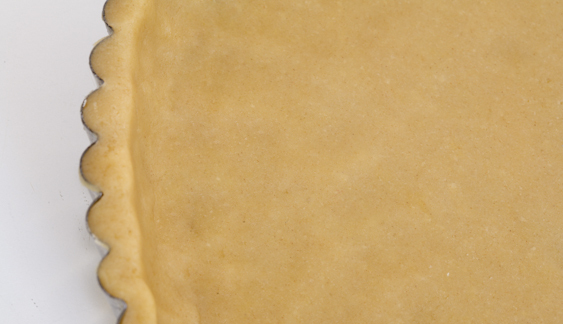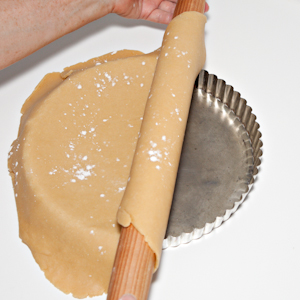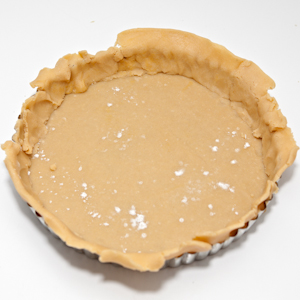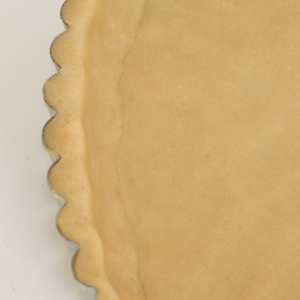Sweet Pastry (Pâte Sablée)

introduction
The pastry is super easy to make, a bit trickier to roll out. Being basically a cookie dough, it won’t stretch like regular pie dough. It tears easily, yes, but it patches easily, too. Roll it out between layers of parchment or plastic wrap and don't hesitate to plunge the dough back into the fridge if it overwarms. If the dough tears on transfer, patch it with bits of itself. Fit it snugly into the pan. The lining must not be too thick (it will be tough) or too thin (it will be frail). When properly fitted, the fluted edges will measure between 3/16 and ¼ inch thick.
Anson Mills flours are “alive.” In the context of a pie dough—which contains liquid and fat—this means the pastry flour will begin to oxidize if the dough languishes unbaked in the refrigerator a day or two. You might see grayish streaks running across a disk of dough after 24 hours. These streaks do not affect the performance or flavor of the pastry. We tested it. Having said this, the best way to work with this recipe is to roll the pastry out and bake it the same day it is made. Or, freeze the dough, then defrost it, roll it out, and bake it promptly.
Ah, the pizza stone. It’s never far from our oven gates. In fact, we rarely remove it from the oven at all. To get a superior bottom crust on a pastry shell, a pizza stone is essential. (If you don’t own one, buy one. You will not regret it.) The crust needs to be blind-baked to completion directly on the stone before it is filled with pastry cream.
equipment mise en place
To make this recipe, you will need a digital kitchen scale; a food processor; a rolling pin; parchment paper or plastic wrap; a 9- to 9½-inch round, 1-inch-deep fluted tart pan with a removable bottom; a pizza stone; aluminum foil; and about 1 quart of pie weights or dried beans for blind baking.
-
-
1large egg yolk
-
0.5ounce (1 tablespoon) heavy cream
-
½teaspoon vanilla extract
-
7ounces (1½ cups) Anson Mills Colonial Style Fine Cloth-Bolted Pastry Flour, plus additional as needed
-
1.75ounces (¼ cup) superfine sugar
-
Scant ½ teaspoon fine sea salt
-
4ounces (8 tablespoons) cold unsalted European-style butter, cut into 1-inch cubes
-
-
Combine the egg yolk, cream, and vanilla in a small bowl and stir with a fork until well blended. Place the flour, sugar, and salt in a food processor, and pulse to combine. Scatter the butter pieces over the surface (fig. 1.1) and pulse until the mixture resembles coarse meal, about ten 1-second pulses. With the machine running, pour the egg-yolk mixture through the feed tube and process until the dough forms a ball that chases itself around the bowl, about 20 seconds (fig. 1.2). Transfer the dough to a work surface; it should be soft and pliable. If it is extremely tacky sprinkle it with up to 1 tablespoon of flour and knead very lightly until incorporated. Press the dough firmly into a disk, wrap it in plastic wrap, and refrigerate for at least 1 hour or up to 24 hours.
-
Remove the dough from the refrigerator; let it stand at room temperature for about 10 minutes until slightly softened. While it is still encased in plastic, rap the dough with a rolling pin to flatten the disk. Unwrap the dough, place it between 2 lightly floured sheets of parchment paper or plastic wrap, and roll it out into a 13-inch round of even thickness (fig. 2.1). (The dough is delicate, but easily patched.) Peel off the top sheet of parchment or plastic and replace it lightly over the dough. Using the edges of the bottom sheet of parchment or plastic, flip the dough round; lift off what is now the top sheet. Using the bottom sheet for assistance, loosely drape and then roll the dough around the rolling pin, pulling away the parchment or plastic as needed (fig. 2.2). Gently unroll the dough over a 9- to 9½-inch round, 1-inch-deep fluted tart pan with a removable bottom (fig. 2.3). Ease the dough squarely into the corners and against the sides of the tart pan (fig. 2.4). Patch any tears or holes, gently press the dough into the flutes of the pan, and then trim away the excess. The walls should have a uniform 3/16-inch to ¼-inch thickness (fig. 2.5), and the bottom crust should be thinner than the walls. Refrigerate the dough-lined tart pan until the dough is firm, at least 30 minutes.
-
Fit a sheet of aluminum foil snugly against the dough, allowing ample overhang. Pour about 1 quart of pie weights or dried beans into the foil; they should come flush with the edge of the tart pan. Refrigerate for 1 hour.
-
While the weighted-down dough is chilling, adjust the oven racks to the lowest and highest positions. Place a pizza stone on the lower rack and heat the oven to 375 degrees, allowing 1 hour for the pizza stone to heat thoroughly.
-
Transfer the dough-lined tart pan directly from the refrigerator to the hot pizza stone and bake until the dough is set and browned, about 30 minutes. Carefully lift out the foil with the pie weights, move the tart pan to the upper rack, and continue baking until the pastry is uniformly crisp and brown, 5 to 10 minutes longer. Let cool to room temperature on a wire rack.
-
-
1.1

-
1.2

-
-
-
2.1

-
2.2

-
2.3

-
2.4

-
2.5

-
A version of this recipe by the same author, Kay Rentschler, originally appeared in Cook’s Illustrated magazine.